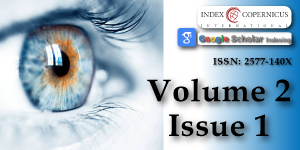The management of Irvine-Gass Syndrome in a patient using Inhaler Steroid
Main Article Content
Abstract
Irvine-Gass syndrome, is one of the most common causes of painless decrease in vision following even uneventful cataract surgery. It usually responds well to medical therapy, but, there are no widely acceptedconsensus on the efficacy of various therapeutic options for the treatment of Irvine-Gass syndrome. The patient presenting in this case report, has systemic hypertension and chronic obstructive pulmonary disease and he use oral anti-hypertension medication and inhaler steroid. He diagnosed as Irvine-Gass syndrome due to presence of decrease in visual acuity and macular edema with hyporeflective cystic intraretinal spaces in optical coherence tomography (OCT) since4th weekcontrol visitfollowing uneventful cataract surgery. After the responsiveness of several medications including topical steroid and non-steroidal anti-inflammatory drugs and intravitreal injection of anti-vascular endothelial growth factor (anti-VEGF), intravitreal sustained-release dexamethasone implant was applied. The visual acuity improved to 0.00 logMAR at 1st month after intravitreal dexamethasone therapy and consecutive OCT images showed complete resolution of macular edema with a normalization of the foveal profile.The visual acuity and foveal architecture remained stable in 2-year follow-up period and additional treatment was not needed. To the best of our knowledge, this is the first reportthatmentions the increment of visual acuity after a single dexamethasone implant, even though it did not response anti-VEGF combined with topical steroid and non-steroidal anti-inflammatory drugs.
Article Details
Copyright (c) 2018 Altintas AGK, et al.

This work is licensed under a Creative Commons Attribution 4.0 International License.
Yonekawa Y, Kim IK. Pseudophakic cystoid macular edema. Curr Opin Ophthalmol. 2012; 23: 26-32. Ref.: https://goo.gl/Ph25rB
Henderson BA, Kim JY, Ament CS, Ferrufino-Ponce ZK, Grabowska A, et al. Clinical pseudophakic cystoid macular edema: risk factors for development and duration after treatment. J Cataract Refract Surg. 2007; 33: 1550-1558. Ref.: https://goo.gl/jEMiYd
Eriksson U, Alm A, Bjärnhall G, Granstam E, Matsson AW. Macular edema and visual outcome following cataract surgery in patients with diabetic retinopathy and controls. Graefes Arch Clin Exp Ophthalmol. 2011; 249: 349-359. Ref.: https://goo.gl/onPmzT
Chu CJ, Johnston RL, Buscombe C, Sallam AB, Mohamed Q, et al. Risk factors and incidence of macular edema after cataract surgery. Ophthalmology. 2016; 123: 316-323. Ref.: https://goo.gl/HgDgU6
Benitah NR, Arroyo JG. Pseudophakic cystoid macular edema. Int Ophthalmol Clin. 2010; 50: 139-153. Ref.: https://goo.gl/c9vnTf
Vukicevic M, Gin T, Al-Qureshi S. Prevalence of optical coherence tomography-diagnosed postoperative cystoid macular oedema in patients following uncomplicated phacoemulsification cataract surgery. Clin Experiment Ophthalmol. 2012; 40: 282-287. Ref.: https://goo.gl/9NtJ4C
Altıntaş AGK, Coban P, Arifoğlu, HB, Koklu G, Ozcan PY, et al. Comparison of phaco parameters effect on macular thickness changes after uneventful phacosurgery in diabetic and non-diabetic patients. Int Eye Sci. 2016; 16: 201-206. Ref.: https://goo.gl/Geqk7q
Kiernan DF, Hariprasad SM. Controversies in the Management of Irvine-Gass Syndrome. Ophthalmic Surg Lasers Imaging Retina. 2013; 44: 522-527. Ref.: https://goo.gl/sooJbP
Randazzo A, Vinciguerra P. Chronic macular edema medical treatment in Irvine-Gass syndrome: case report. Eur J Ophthalmol. 2010; 20: 462-465. https://goo.gl/DkU34D
Chylack LT Jr, Leske MC, McCarthy D, Khu P, Kashiwagi T, et al. Lens opacities classification system II (LOCS II). Arch Ophthalmol. 1989; 107: 991-997. Ref.: https://goo.gl/fxN3Yn
Quintana NE, Allocco AR, Ponce JA, Magurno MG. Non-steroidal anti-inflammatory drugs in the prevention of cystoid macular edema after uneventful cataract surgery. Clin Ophthalmol. 2014; 8: 1209-1212. Ref.: https://goo.gl/Xp6PC8
Dal D, Sarac O, Toklu Y, Kocak Altintas AG, Cakmak HB, et al. The Effect of Perioperative Topical Ketorolac 0.5% on Macular Thickness after Uneventful Phacoemulsification. J Ophthalmol. 2017. Ref.: https://goo.gl/tLxfU7
Yilmaz T, Cordero-Coma M, Gallagher MJ. Ketorolac therapy for the prevention of acute pseudophakic cystoid macular edema: a systematic review. Eye. 2012; 26: 252-258. Ref. https://goo.gl/b51r3v
Barone A, Russo V, Prascina F, DelleNoci N. Short-term safety and efficacy of intravitreal bevacizumab for pseudophakic cystoid macular edema. Retina. 2009; 29: 33-37. Ref.: https://goo.gl/vRa5Qy
Kessel L, Tendal B, Jørgensen KJ, Erngaard D, Flesner P, et al. Post-cataract prevention of inflammation and macular edema by steroid and nonsteroidal anti-inflammatory eye drops. A systematic review. Ophthalmology. 2014; 121: 1915-1924. Ref.: https://goo.gl/hgtH8v
Mason JO, Albert MA, Vail R. Intravitreal bevacizumab (Avastin) for refractory pseudophakic cystoid macular edema. Retina. 2006; 26: 356-357. Ref.: https://goo.gl/vpPxgs
Spitzer MS, Ziemssen F, Yoeruek E, Petermeier K, Aisenbrey S, et al. Efficacy of intravitreal bevacizumab in treating postoperative pseudophakic cystoid macular edema. J Cataract Refract Surg. 2008; 34: 70-75. Ref.: https://goo.gl/TxVbjh
Mitropoulos PG, Chatziralli IP, Peponis VG, Drakos E, Parikakis EA. Intravitreal Ranibizumab for the Treatment of Irvine-Gass Syndrome. Ocul Immunol Inflamm. 2015; 23: 225-231. Ref.: https://goo.gl/uAoCqE
Demirel S, Batioglu F, Ozmert E. Intravitreal Ranibizumab for the Treatment of Cystoid Macular Edema in Irvine-Gass Syndrome. J Ocul Pharmacol Ther. 2012; 28: 636-639. Ref.: https://goo.gl/u78ERb
Benhamou N, Massin P, Haouchine B, Audren F, Tadayoni R, et al. Intravitreal triamcinolone for refractory pseudophakic macular edema. Am J Ophthalmol. 2003; 135: 246-249. Ref.: https://goo.gl/SFrcu7
Williams GA, Haller JA, Kuppermann BD, Blumenkranz MS, Weinberg DV, et al. Dexamethasone posterior-segment drug delivery system in the treatment of macular edema resulting from uveitis or Irvine-Gass syndrome. Am J Ophthalmol. 2009; 147: 1048-1054. Ref.: https://goo.gl/mZocX6
Medeiros MD, Navarro R, Garcia-Arumí J, Mateo C, Corcóstegui B. Dexamethasone Intravitreal Implant for Treatment of Patients With Recalcitrant Macular Edema Resulting From Irvine-Gass Syndrome. Investigative Ophthalmology & Visual Science. 2013; 54: 3320-3324.
Bellocq D, Korobelnik JF, Burillon C, Voirin N, Dot C, et al. Effectiveness and safety of dexamethasone implants for post-surgical macular oedema including Irvine-Gass syndrome: the EPISODIC study. Br J Ophthalmol.2015; 99: 979-983. Ref.: https://goo.gl/NYX6TD
Mayer WJ, Kurz S, Wolf A, Kook D, Kreutzer T, et al. Dexamethasone implant as an effective treatment option for macular edema due to Irvine-Gass syndrome. J Cataract Refract Surg. 2015; 41: 1954-1961. Ref.: https://goo.gl/N7jF5N





